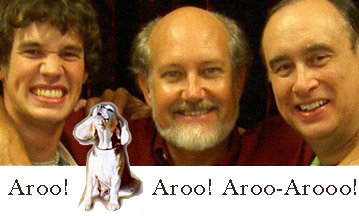
[Just a bit more introduction, and then you can read the memo. That’s one of my first blog students, Chris Busch, on Roy’s right, his son Ryan on the left. They attended Magical Worlds together last week. I’ve attended with my wife and my oldest daughters. It’s an experience that is best shared with the people you’ll be attempting to explain it to when you get home. -Dave]
By Roy H. Williams
Okay, let’s be clear about this: I’m proud of myself today. So proud, in fact, that you might want to skip reading this memo because all I’m going to do is strut. It could become sickening. Seriously.
Frankly, I can’t believe you’re still reading after a warning like that.
First it was Dr. Burkhardt Maess of the Max Planck Institute for Cognitive Neuroscience who proved my longstanding assertion that Broca’s area of the brain anticipates the predictable. (This is important to you and me because Predictability is the killer of attention. If we want to gain and hold human attention, we must know how to stimulate Broca.)
Now neurologist Friedemann Pulvermuller of the Medical Research Council in Cambridge has shocked the scientific community by announcing that Wernicke’s area and Broca’s area gather sensory data from other brain areas and then compile it into complex mental images. According to the article, "These results challenge the theory that isolated, language-specific brain structures discern word meanings. Instead, they propose word understanding hinges on activation of interconnected brain areas that pull together knowledge about that particular word and its associated actions and sensations."
Anyone who has attended one of my public seminars since 1996 has heard me explain this whole "pulling sensory data from associated areas" process in detail. I wrote about it in a series of Monday Morning Memos in 2001 and 2002 and then finally laid the matter to rest with the April, 2003 publication of the audiobook with transcript, Thought Particles: Binary Code of the Mind. Its description says, "This limited-edition insight contains one audio CD and one illustration CD unveiling the Wizard’s theories on how thoughts are assembled in the mind from stored sensory associations."
Why does any of this matter? CONTINUE READING AT WIZARD ACADEMY
